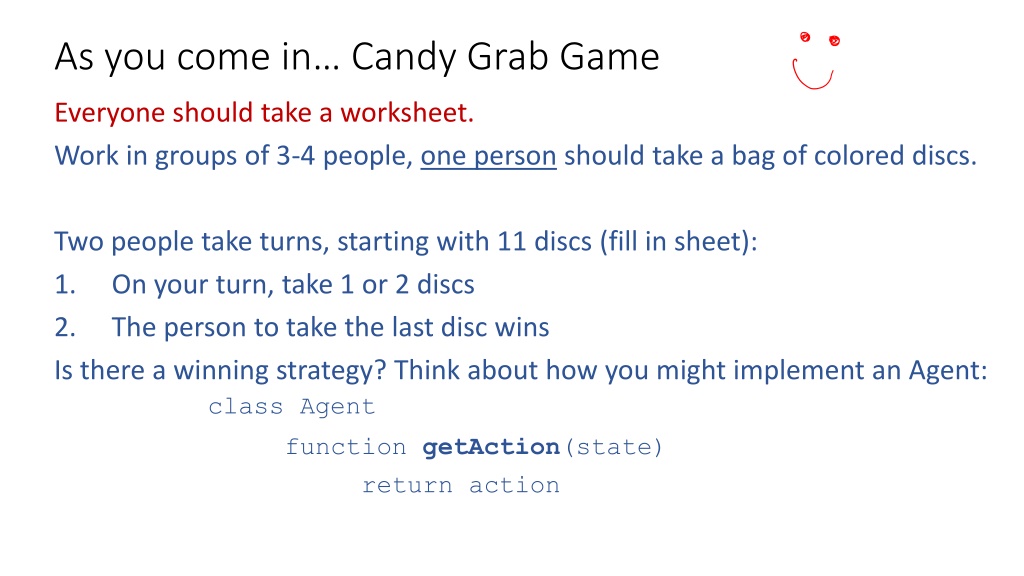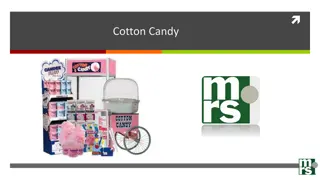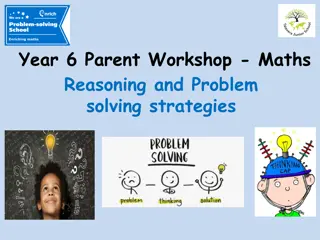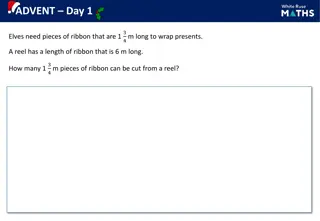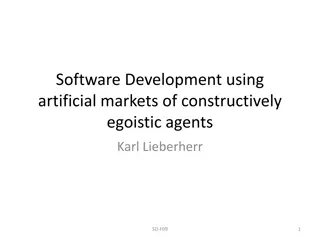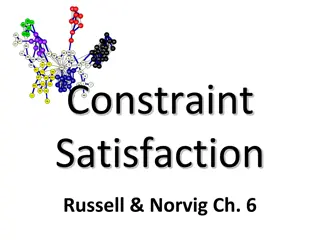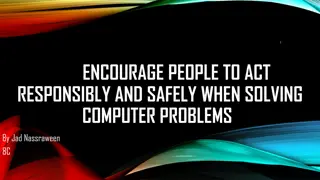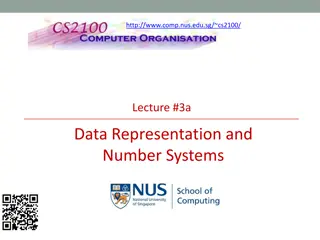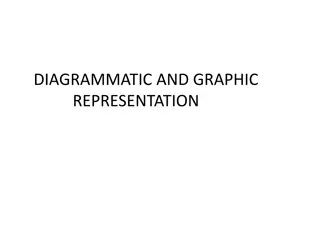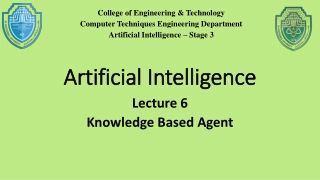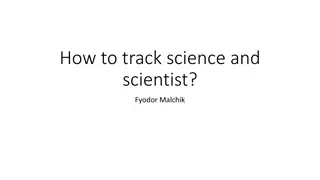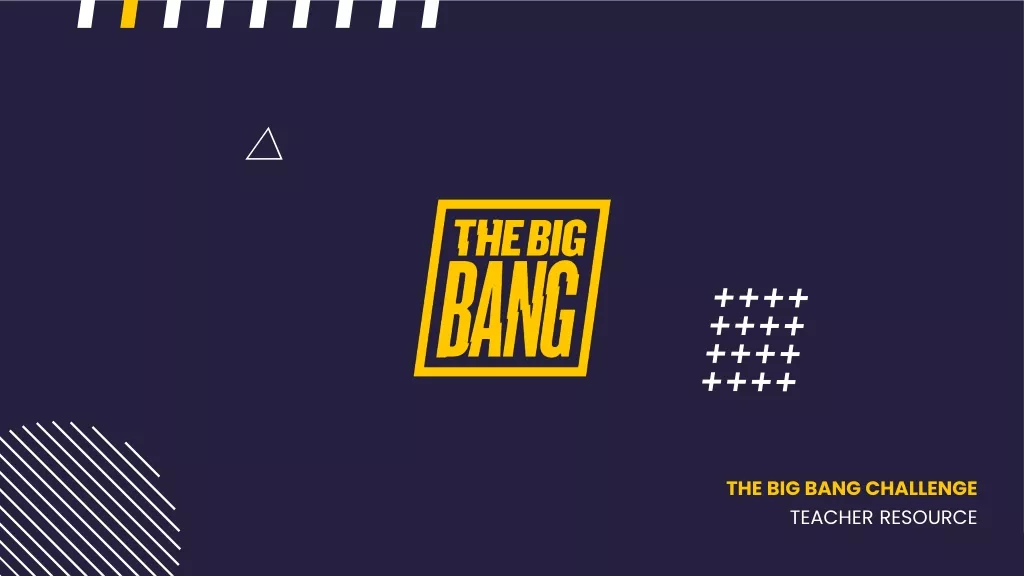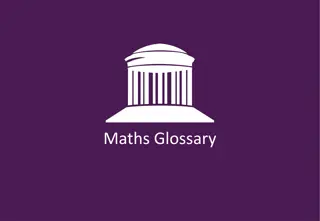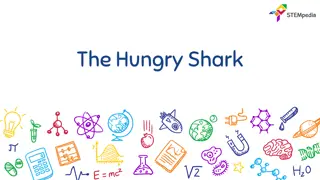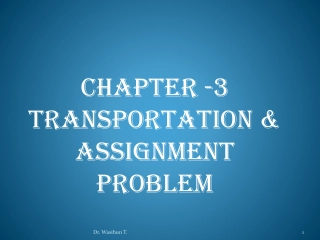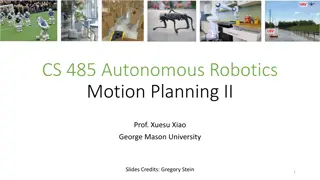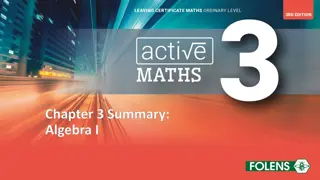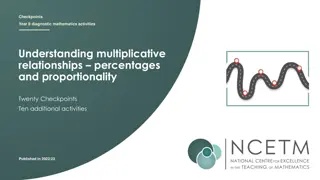AI Representation and Problem Solving in Candy Grab Game
In the Candy Grab Game, players take turns grabbing colored discs from a bag in groups of 3-4. They strategize to ensure they don't take the last disc to win. The concept explores implementing an AI agent to determine winning strategies and actions based on the game dynamics. The course taught by Stephanie Rosenthal covers AI representation and problem-solving techniques to enhance gameplay and decision-making.
Download Presentation
Please find below an Image/Link to download the presentation.
The content on the website is provided AS IS for your information and personal use only. It may not be sold, licensed, or shared on other websites without obtaining consent from the author. Download presentation by click this link. If you encounter any issues during the download, it is possible that the publisher has removed the file from their server.
Presentation Transcript
As you come in Candy Grab Game Everyone should take a worksheet. Work in groups of 3-4 people, one person should take a bag of colored discs. Two people take turns, starting with 11 discs (fill in sheet): 1. On your turn, take 1 or 2 discs 2. The person to take the last disc wins Is there a winning strategy? Think about how you might implement an Agent: class Agent function getAction(state) return action
AI: Representation and Problem Solving Introduction Instructor: Stephanie Rosenthal Slide credits: CMU AI & http://ai.berkeley.edu
Teaching Assistants Course Team Instructor Olivia Ihita (Head TA) Simrit (Head TA) Stephanie Rosenthal Raashi Gavin Alex Mansi Josep Lily
Course Information Website: www.cs.cmu.edu/~15281 Canvas: canvas.cmu.edu Gradescope: gradescope.com Communication: www.piazza.com/cmu/spring2023/15281 (password AIRPS-S23) E-mail: srosenth@andrew.cmu.edu Prerequisites/Corequisites/Course Scope
Participation Points and Late Days Participation points! Last semester we had 65 points - Lecture Polls - In-Class Activities - Recitation Attendance Late Days - 6 late days to use during the semester - At most 2 can be used on a single programming assignment - At most 1 can be used on a single online/written assignment
Safety and Wellness Virtual and in-person office hours! Lectures are recorded for everyone to use, no questions asked. Use the late days appropriately. Contact me ASAP if you think you ll miss more than one class so we can make a plan for how to catch up!
Announcements Recitation starting this Friday Recommended. Materials are fair game for exams Attendance counts towards participation points Choosing sections Assignments: P0: Python & Autograder Tutorial (out now) Required, but worth zero points Already released Due Friday 1/20, 10 pm (no OH on Fridays!) HW1 (online) Released Today! Due Tues 1/24, 10 pm
Today An AI game What is AI? A brief history of AI State representation and world modeling
Candy Grab Agent class Agent function getAction(state) return action
Candy Grab Agent Agent 001 Always choose 1 function getAction( numPiecesAvailable ) return 1
Candy Grab Agent Agent 004 Choose the opposite of opponent function getAction( numPiecesAvailable ) return ?
Candy Grab Agent Agent 007 Whatever you think is best function getAction( numPiecesAvailable ) return ?
Candy Grab Agent Agent 007 Whatever you think is best function getAction( numPiecesAvailable ) if numPiecesAvailable % 3 == 2 return 2 else return 1
Participation Poll Question Games Three Intelligent Agents Which agent code is the most intelligent ?
Games Three Intelligent Agents A: Search / Recursion 11 10 9 9 8 8 7 8 7 2 0 1 +1 +1 -1
Games Three Intelligent Agents B: Encode the pattern 10 s value:Win 9 s value:Lose 8 s value:Win 7 s value:Win 6 s value:Lose 5 s value:Win 4 s value:Win 3 s value:Lose 2 s value:Win 1 s value:Win 0 s value:Lose function getAction( numPiecesAvailable ) if numPiecesAvailable % 3 == 2 return 2 else return 1
Games Three Intelligent Agents C: Record statistics of winning positions Pieces Available 2 2 2 2 Pieces Available Pieces Available Pieces Available Take 1 Take 1 Take 1 Take 1 0% Take 2 Take 2 100% 100% 100% Take 2 Take 2 3 3 3 3 0% 2% 0% 4 4 4 4 100% 100% 75% 2% 5 5 5 5 4% 68% 6 6 6 6 5% 6% 7 7 7 7 60% 100% 50% 5%
Poll question Games Three Intelligent Agents Which agent code is the most intelligent ? Which agent code is the most intelligent ? A. Search / Recursion B. Encode multiple of 3 pattern C. Keep stats on winning positions
What is AI? The science of making machines that: Think like people Think rationally Act like people Act rationally
Turing Test In 1950, Turing defined a test of whether a machine could think A human judge engages in a natural language conversation with one human and one machine, each of which tries to appear human. If judge can t tell, machine passes the Turing test en.wikipedia.org/wiki/Turing_test
What is AI? The science of making machines that: Think like people Think rationally Act like people Act rationally
Rational Decisions We ll use the term rational in a very specific, technical way: Rational: maximally achieving pre-defined goals Rationalityonly concerns what decisions are made (not the thought process behind them) Goals are expressed in terms of the utility of outcomes Being rational means maximizing your expected utility A better title for this course would be: Computational Rationality
What About the Brain? Brains (human minds) are very good at making rational decisions, but not perfect Brains aren t as modular as software, so hard to reverse engineer! Brains are to intelligence as wings are to flight Lessons learned from the brain: memory and simulation are key to decision making
Rationality, contd. What is rational depends on: Performance measure Agent s prior knowledge of environment Actions available to agent Percept sequence to date Being rational means maximizing your expected utility
Rational Agents Are rational agents omniscient? No they are limited by the available percepts and state Are rational agents clairvoyant? No they may lack knowledge of the environment dynamics Do rational agents explore and learn? Yes in unknown environments these are essential So rational agents are not necessarily successful, but they are autonomous (i.e., make decisions on their own to achieve their goals)
Maximize Your Expected Utility
A Brief History of AI Knowledge Based Systems 1970-1990 AI Excitement! 1950-1970 artificial intelligence formal logic https://books.google.com/ngrams
What went wrong? Dog Buster Barks Has Fur Has four legs
A Brief History of AI Knowledge Based Systems 1970-1990 Deep Statistical Approaches 1990- AI Learning Era 2012- Excitement! 1950-1970 https://books.google.com/ngrams
A Brief History of AI 1940-1950: Early days 1943: McCulloch & Pitts: Boolean circuit model of brain 1950: Turing's Computing Machinery and Intelligence 1950 70: Excitement: Look, Ma, no hands! 1950s: Early AI programs, including Samuel's checkers program, Newell & Simon's Logic Theorist, Gelernter's Geometry Engine 1956: Dartmouth meeting: Artificial Intelligence adopted 1970 90: Knowledge-based approaches 1969 79: Early development of knowledge-based systems 1980 88: Expert systems industry booms 1988 93: Expert systems industry busts: AI Winter 1990 : Statistical approaches Resurgence of probability, focus on uncertainty General increase in technical depth Agents and learning systems AI Spring ? 2012 : Deep learning 2012: ImageNet & AlexNet Images: ai.berkeley.edu
Artificial Intelligence vs Machine Learning? Artificial Intelligence Machine Learning Deep Learning
What Can AI Do? Quiz: Which of the following can be done at present? Play a decent game of table tennis? Play a decent game of Jeopardy? Drive safely along a curving mountain road? Drive safely across Pittsburgh? Buy a week's worth of groceries on the web? Buy a week's worth of groceries at Giant Eagle? Discover and prove a new mathematical theorem? Converse successfully with another person for an hour? Perform a surgical operation? Put away the dishes and fold the laundry? Translate spoken Chinese into spoken English in real time? Generate intentionally funny memes?
Designing Agents An agent is an entity that perceives and acts. Characteristics of the percepts and state, environment, and action space dictate techniques for selecting actions Environment Sensors How can we design an AI agent to solve our problems given their task environments? Percepts Agent ? Actuators Actions
Pac-Man as an Agent Environment Agent Sensors Percepts World Model States Transitions Costs/Utilities ? Actuators Actions Pac-Man is a registered trademark of Namco-Bandai Games, used here for educational purposes
Representing an AI problem (PEAS) A task environment consists of: A state space - what the agent knows about the world For each state, a set of Actions(s) of allowable actions OR Value(s) to assign to states {N, E} 1 N Environmental dynamics how the world moves when the agent acts in it E 1 Performance measure as a metric for utility/reward/cost
Task Environment - Pacman Performance measure -1 per step; +10 food; +500 win; -500 die; +200 hit scared ghost Environment Pacman dynamics (incl ghost behavior) Actions North, South, East, West, (Stop) State where pacman is all dots? all ghosts?
Task Environment Automated Taxi Performance measure Income, happy customer, vehicle costs, fines, insurance premiums Environment US streets, other drivers, customers Actions Steering, brake, gas, display/speaker State Information Camera, radar, accelerometer, engine sensors, microphone Image: http://nypost.com/2014/06/21/how-google-might-put-taxi-drivers-out-of-business/
Environment Types Pacman Taxi Fully or partially observable Single agent or multi-agent Deterministic or stochastic Static or dynamic Discrete or continuous
Whats in a State Space? The real world state includes every last detail of the environment A state (for AI) abstracts away details not needed to solve the problem Problem: Pathing State representation: (x,y) location Actions: NSEW Transition model: update location Goal test: is (x,y)=END Problem: Eat-All-Dots State representation: {(x,y), dot booleans} Actions: NSEW Transition model: update location and possibly a dot boolean Goal test: dots all false
State Space Sizes? World state: Agent positions: 120 Food count: 30 Ghost positions: 12 Agent facing: NSEW How many World states? 120x(230)x(122)x4 States for pathing? 120 States for eat-all-dots? 120x(230)
Safe Passage Problem: eat all dots while keeping the ghosts perma-scared What does the state representation have to specify? (agent position, dot booleans, power pellet booleans, remaining scared time)
Designing Agents An agent is an entity that perceives and acts. Characteristics of the percepts and state, environment, and action space dictate techniques for selecting actions This course is about: General AI techniques for a variety of problem types Learning to recognize when and how a new problem can be solved with an existing technique Environment Sensors Percepts Agent ? Actuators Actions
In-Class Activity Part 2 Answer Poll Question at the end
Take some candy on the way out! Return the bag of discs! Summary: - An agent perceives the world and acts in it - PEAS framework for task environments - Environment types - State space calculations - Rationality
